- Your cart is empty
- Continue Shopping

VARANASI – THE LAND OF BABA VISHWANATH
KASHI MAHATMYA
Kashi, which illuminates the entire universe with supernatural knowledge, Kashi, the oldest city of the world, seated with the form of Lord Vishweshwara. Kashi, the best creation of Vishwakarma, which Lord Shiva himself then called Anandakanan, immortal and imperishable.
Being situated between the Varuna and Asi rivers on the banks of the Mother Ganges. The whole city knows by the name of Varanasi. It is called Purnatirtha, Tapasthali, Kasika, It is also known by the names of Avimukt, Anandavan, Apunarbhabhumi, Rudravas and Mahashamshan etc. The mention of Kashi is found in the Rigveda, the oldest text of the world. According to the Puranas, this is a proto-Vaishnavite place. Earlier it was the place of Lord Vishnu (Madhava), where the point became the lake due to the fall of Srihari Anandanu(Tears of Happiness) and the Lord is here in the name of Bindumadhav.

Honored. It is described in Matsya Purana that Kashi is the supreme place of Brahma ji, mastered by Brahma, always served and protected.
In Skanda Purana, Kashi has been called Brahma Rasayana and not a piece of land. Lord Vishweshwara has called Brahma Rasayan of Kashi, the land of the most beloved Param Saukhya in Trilok. It is described in Skanda Purana itself that it is different and eternal truth form than Kashipuri Trailokya. Kashi is seated on the trident of Lord Shankar. Quotes related to the importance of Kashi are found in Rigveda, Atharvaveda, Shatapatha Brahmana, Gopatha Brahmana, the word ‘Kashi’ and in all the texts including Brihadaranyakopanishad, Valmiki Ramayana, Mahabharata, Ashtadhyayi.

Maharishi Vyas, while describing Kashi as the navel of Trilokya, has said that the nabhibhuta Shubhadaya to the entire Dharitri, this Kashi does not disappear even during the doomsday. According to the Linga Purana, while propounding the specialty of Kashi, It is said is my deepest region and is always the cause of salvation of beings. Kashi has always been the center of spirituality, culture and education. Lord Buddha got knowledge in Bodh Gaya, but for turning the wheel of Dharma, he went to Kashi, the center of knowledge and spirituality. Rishi comes the port (Sarnath). Adiguru Shankaracharya, the greatest spokesperson of Vedanta, comes to Kashi from a place called Kaladi in the state of Kerala. The great Saint Nanak and in medieval times Prince Darashikoh visit Kashi. In Kashi, there is an echo of nirguna in Kabir’s voice, then through the story of Ram, Tulsi Das works to establish a coordination between sagun and nirguna. The world accepted what Kashi accepted. Bharat Ratna Pandit Mahamana Madan Mohan Malviya also came from Prayag and established Banaras Hindu University in Varanasi itself. Kashi has been the most prestigious center of Brahmoday (dialogue) in the world. Here the ancient tradition of debate is still alive in Sanskrit schools. Kashi Hindu Sanatan Parampara along with other Hindu religious traditions, beliefs has also been assimilated in itself. Kashi is not just a complete city. Kashi, the city of Lord Shiva, is a living example of universal harmony, so because it has been a center of attraction for all religions.
VARANASI AND KABIR DAS
This holy land of Kashi has produced many such saints from time to time, who have made the life path simple, restrained and with high ideals, making human life flawless. Among such saints, the description of Kabir Das comes in the front lines.
VARANASI AND TULSI DAS
The founder of the era, Tulsidasji has a great attachment to Kashi. Apart from Ayodhya Chitrakoot, he had spent valuable moments of life in Kashi itself and there is a context of him presenting his Ramcharit Manas scripture to Kashi scholarly congregation, considering the Shivling of Shri Kashi Vishwanath temple as a witness.
During the reign of external invaders and Mughals, when everyone was being forced to convert, then through boldly staging Ramcharit Manas and Ramlila, Tulsidas from this Kashi conveyed the proclamation of Raja Ramchandra ji’s Jai Ho to village-village.
VARANASI AND SANT SHIROMANI RAVI DAS
Sant Shiromani Ravidas ji is known as Ravidas in Punjab and Uttar Pradesh, Madhya Pradesh and Known as Raidas in Rajasthan. He was born in Govardhanpur village of this Kashi on the full moon date of measurement month of 1376. Therefore, every year on Gandhi Purnima, his birth anniversary is celebrated with great pomp all over the country.
VEDIC MANTRAS RESONATES IN KASHI
The divine dham of Baba Vishwanath in Kashi, the place of Mata Annapurna, Kalbhairav, Bada Ganesha, Navgauri, Navadurga, Chappan Vinayak, Dwadash Aditya, Ashta Bhairav, and sixty-four yoginis, along with the worship mantras of the sixty-four yoginis, still reverberate in the streets of the pucca mahal. Here is the tradition of debate is still alive in Sanskrit schools. In the context of its origin, it is described in the Kashi section of Skanda Purana that Lord Shiva himself, while traveling in this earthly world with Skanda Mata Parvati, by his own virtuous deity, as per his wish, ecstatic from the ecstatic nature of the nature and the Supreme Personality of God (Self). He created such a city of giving, where Lord Shiva himself along with Mother Parvati could reside till the end. According to the Skanda Purana, the form of the city of Kashi is in the shape of a trident in Satyuga, in the shape of a wheel in Treta, in the shape of a chariot in Dwapar and in the shape of a conch in this Kaliyuga. That is why Kashi is said to be situated on the trident of Lord Shiva, because the first form of these figures is Trishul itself.
Ayodhya, Mathura, Maya (Haridwar), Kashi (Varanasi), Kanchi, Avantika (Ujjayini) and Dwarka Dham are the seven Mokshapuris, but in the end Kashi is considered to be the provider of salvation.
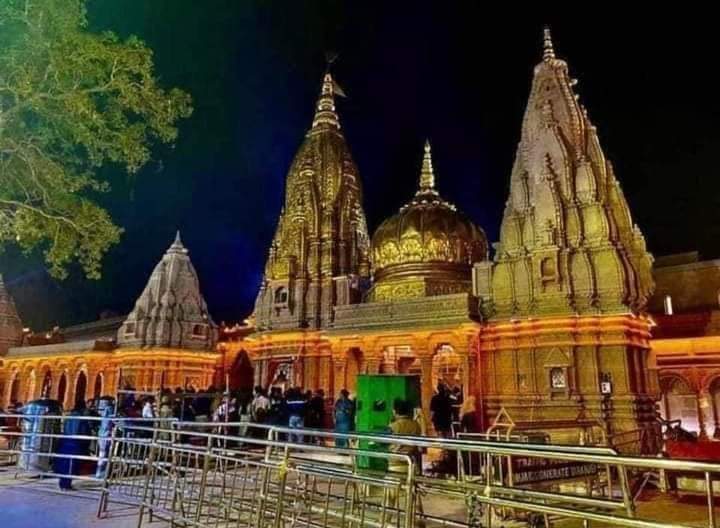
But Kashi is the only one who gives real salvation, as it is mentioned that in Kashi • the person who renounces his life is not reborn. The good fortune of traveling to Muktidayini Kashi, residence, death and cremation here is obtained by the virtues of previous births and by the grace of Baba Vishwanath. The mere presence of Kashi destroys sins.
THE KASHI VISHWANATH JYOTIRLING
According to mythological beliefs, Lord Shiva is present in the form of Jyotirlinga at twelve places. Shri Somnath in Saurashtra Pradesh (Kathiawad), Shri Mallikarjun on Shri Shailam, Shri Mahakal in Ujjayini (Ujjain), Omkareshwar or Mamleshwar in Khandwa district near Ujjain, Vaidyanath in Parli, Shri Bhimashankar at Dakini, Shri Rameshwar on Setubandh, Darukavan In Sri Nageshwar, Sri Vishwanath in Varanasi (Kashi), Sri Tryambakeshwar on the banks of Gautami (Godavari), Sri Kedarnath in Kedarkhand on the Himalayas and Sri Ghrishneshwar in Pagoda, it is believed that a person who remembers these twelve Jyotirlingas every morning and evening. The sin committed in his seven births is destroyed by the mere remembrance of these lingas. Kashi Vishwanath Jyotirling is located in Kashi. On the north side of Kashi is Akarkhand, Kedarkhand in the south and Vishweshwarkhand in the middle. The famous Vishwanath Jyotirlinga is situated in this section. In the Puranas, this story has been given in relation to this Jyotirlinga that Lord Shankar was living on Mount Kailash after marrying Parvati ji, but Parvati ji did not like to spend married life in the father’s house there. One day he told Lord Shiva that you take me to your house, I do not like to live here. Lord Shiva accepted his word. Then Lord Shiva came to his holy city Kashi with mother Parvati ji. Coming here, he was established in the form of Vishwanath Jyotirlinga.

Along with the antiquity of Kashi, the antiquity of Shri Kashi Vishwanath Temple is also proved in the form of Jyotirlinga of Lord Shiva.
This temple of Lord Shiva located in the city of Varanasi is one of the ancient Hindu temples, which is situated on the western bank of the river Ganges. The Jyotirlinga form of Lord Shiva is worshiped in this temple since ancient times.
EFFORTS TO DESTROY SHRI KASHI VISHWANATH TEMPLE
According to historians, the Sri Kashi Vishwanath temple was renovated in the 11th century by King Harishchandra. But, in the year 1194, it was demolished by Muhammad Ghori. Qutbuddin Aibak and Shahabuddin Ghori conquered Varanasi in 1194 AD. And he handed over the rule of Varanasi to one of his subedars, Syed Jamaluddin. While trying his best to remove idol worship from Banaras, he destroyed the Shri Kashi Vishwanath temple. Later this temple was rebuilt by Sanatan Samaj.
DEMOLITION BY MAHMUD SHAH IN 1447
After the temple was rebuilt, it was demolished by Sultan Mahmud Shah of Jaunpur in the year 1447. During the time of Mahmud Shah Shark (1436 – 1458 AD), the demolition of the temples of Banaras had started again. The Lal Darwaza Masjid of Jaunpur was built in 1447 AD. At the same time this temple of Shri Kashi Vishwanath was also demolished.
RECONSTRUCTION OF SHRI KASHI VISHWANATH TEMPLE WITH THE HELP OF TODARMAL
During the reign of Akbar, Narayan Bhatt rebuilt the Kashi Vishwanath temple around 1585 with the help of his minister Raja Todarmal. Todarmal’s son Govardhan, Govardhandhari or Gharu is credited for the religious work here. It is the opinion of historians that the temple or stepwells built in Banaras in the name of Todarmal were built by Govardhan.
DEMOLITION ATTEMPTED BY SHAH JAHAN
In 1632, Shah Jahan passed an order and sent an army to destroy the temple, but Due to the strong resistance of the Hindus, his forces could not break the central temple of Vishwanath temple, but 63 other temples of Kashi were definitely demolished.
DEMOLITION BY AURANGZEB
On April 18, 1669, Aurangzeb issued a decree ordering the destruction of the Kashi Vishwanath temple. (This edict is still preserved in the Asiatic Library, Kolkata.) The destruction is described in a book written by the author of the time, Saki Mustaid Khan. Aurangzeb had ordered that the Kashi Vishwanath temple should not only be demolished, but it should be ensured that the temple could not be built there again. Therefore, on the orders of Aurangzeb, after breaking the temple here, a Gyanvapi mosque was built on the sanctum sanctorum or by breaking the sanctum itself. On 2 September 1669, Aurangzeb was informed of the completion of the demolition of the temple.
RECONSTRUCTION BY AHILYABAI HOLKAR
Between 1752 and 1780, Maratha Sardar Dattaji Scindia and Malharrao Holkar made efforts to liberate the temple. On 7 August 1770 AD, Mahadji Scindia got the Emperor of Delhi, Shah Alam, issued an order to recover the compensation for breaking the temple, but by then the East India Company had ruled Kashi, so the renovation of the temple stopped. This temple was rebuilt by Maharani Ahilyabai of Indore in 1777-80. Later, Maharaja Ranjit Singh of Punjab decorated the top of the temple with golden letters. Maharani Baijabai of Gwalior built the pavilion and Maharaja Nepal got a huge Nandi statue installed there.
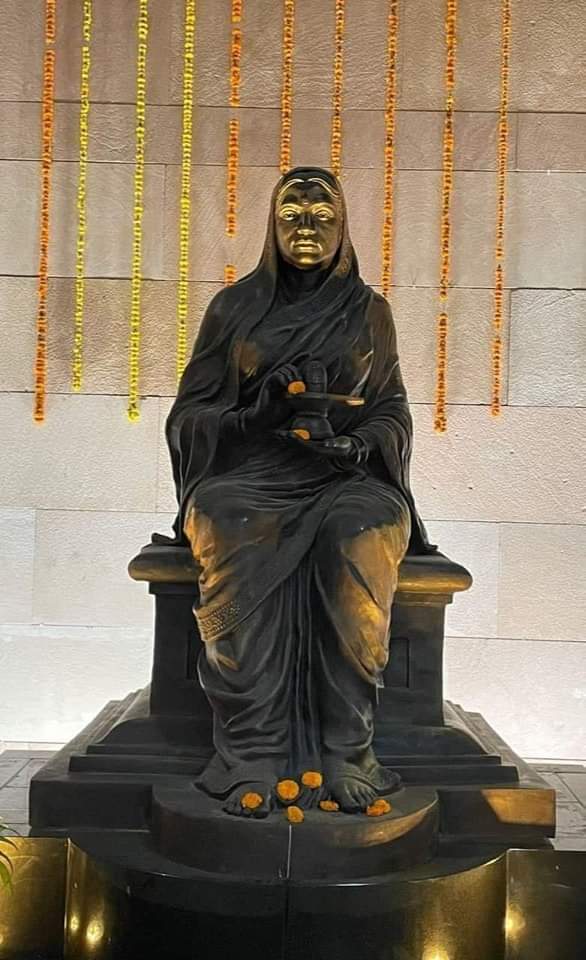
The mention of temples and their destruction come to the fore in the period from 11th to 17th century in history. Jinpram Suri, a contemporary of Muhammad Tughlaq (1325), has written in the book “Vividh Kalp Teerth” that the area of Baba Vishwanath temple was called Dev Kshetra. Historian Furr has also written that some temples were converted into mosques during the time of Firoz Shah Tughlaq. In 1460, Vachaspati in his book “Tirtha Chintamani” describes that Avimukteshwar and Vishveshwara are the same linga.
Thus according to history, the events of construction and demolition of Shri Kashi Vishwanath Temple continued from 11th century to 17th century. Although on 30 December 1810, the then District Magistrate of Banaras, Mr. Watson had written a letter to the ‘Vice President in Council asking to hand over the Gyanvapi complex Sri Kashi Vishwanath Temple to the Hindus forever, but this was never possible.
The linga deity of the main deity in the temple is 60 cm (24 in) tall and 90 cm (35 in) in circumference placed in a silver altar. The main temple is quadrangular and is surrounded by temples of other deities. There are small temples of Kaal Bhairav, Kartikeya, Avimukteshwar, Vishnu, Ganesh, Shani, Shiva and Parvati in the complex. There is a small well in the temple, which is called Gyanvapi well. The Gyanvapi well is situated to the north of the main temple. It is said that the head priest of the temple jumped into the well along with the Shivling to save the Jyotirlinga from the invaders.
According to the aspirations of the people, cleanliness and beauty of Kashi, of the eighty-four ghats, of Mother Ganga are among the priorities of PM Narendra Modi ji. Better facilities, better connectivity, beautiful lanes and ghats, these are the new manifestation of the age-old Kashi.
From strengthening the traditional industry of Kashi to increasing new investment, all-round work is being done on providing employment to self-employment and business opportunities. “The International Convention Center is dedicated to the rich heritage of art, literature and music of Kashi, received in the form of Rudraksh.
The richness of the ancient splendor of Kashi is also associated with the Ganges of knowledge. Under the vision of Modi ji, Kashi continues to develop continuously as a center of modern knowledge and science. With many institutes like model schools, ITIs, polytechnics and new facilities, Kashi is constantly being established as a knowledge center. The Kashi Kendra of Central Institute of Plastic Engineering and Technology (CIPET) is going to give energy to the industrial development of Purvanchal, which is going to strengthen the role of Kashi in training skilled youth to build a self-reliant India.
CULTURAL AND SPIRITUAL GROWTH OF GRAND VARANASI
Dedicated to saving the country’s cultural heritage and symbols of faith for future generations, Narendra Modi ji is making continuous efforts in this direction. It is the result of his tireless efforts that the idol of Mother Annapurna, which was stolen from Kashi more than 100 years ago, has now returned to her home in Kashi. It is a matter of great fortune for Kashi. These ancient idols of our gods and goddesses are a symbol of our faith as well as our priceless heritage. With the arrival of Mata Annapurna to Kashi, the pride of the people’s faith has become more lit.

Narendra Modi ji says that whatever is happening for the development of Kashi, everything is going on with the blessings of Mahadev and the efforts of the people of Banaras. The relentless journey of development even during the corona pandemic has proved the mood of Kashi that this city of Baba never stops, never gets tired, never stops! The new heights of development have once again proved this nature of Kashi.
NEW CONSTRUCTION OF SHRI KASHI VISHWANATH DHAM
Dham The people’s representative of Kashi and Kashi’s own Narendra Modi ji has shed a steady stream of development here, its climax point is his decision to build a grand and divine Vishwanath Corridor till Baba’s court.
It has always been a dream of Modi ji that with the blessings of Baba Vishwanath, he can do something for Kashi that when the devotees come to see Baba, their heart becomes happy. Such is the vision of Modi ji behind the new construction of Shri Kashi Vishwanath Dham.
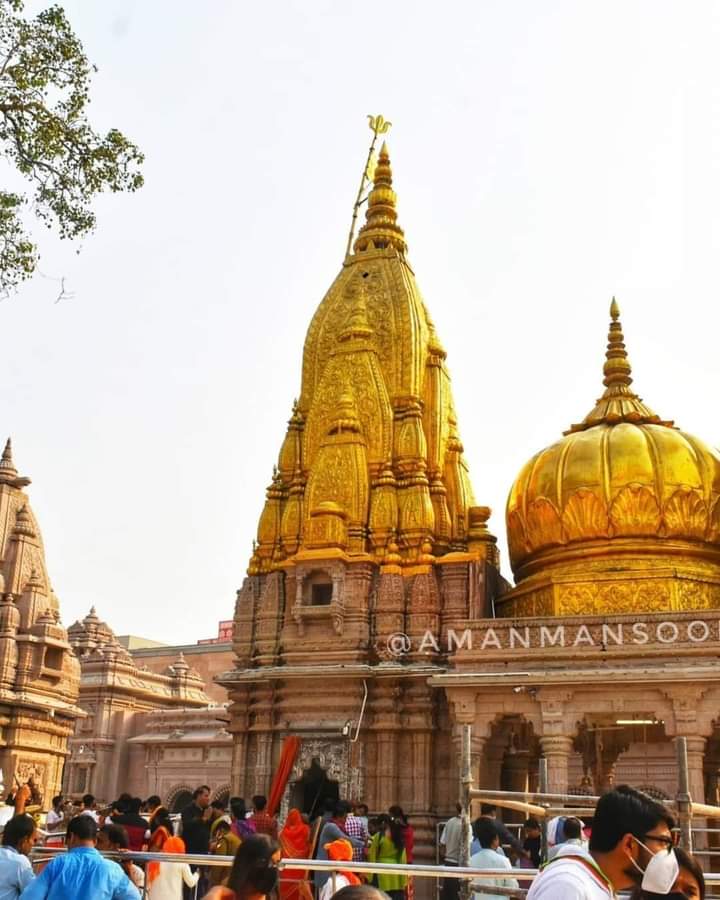
In the olden times, devotees used to offer Gangajal to Baba in Vishwanath Dham by filling water from Maa Ganga, but
This was not possible due to uncontrolled and haphazard construction over time. of public faith
The determination and decisive leadership needed to revive the invaluable tradition and pride of Kashi was possible only from an unequaled personality like Prime Minister Narendra Modi. When the plan of Shri Vishwanath Dham Corridor was drafted, it seemed impossible to implement it on the ground due to its population and inch-by-inch settlement, but Modi ji with a clear will solved all the hurdles. He talked about taking everyone along with the dialogue. It also yielded great results.
There was not a single legal hurdle, no litigation, during the resettlement of about 300 properties and occupants for the project. From planning to the nuances of architecture and design, Shri Narendra Modi, who constantly gave his inputs, suggested to ensure the accessibility of Divyangjan.

During the construction work of the project, Modi ji was completely associated with it. they worked
Self-monitored progress. kept the udi model of the project in his office during corona. He continued to supervise and direct online at the time of corona
With the blessings of Mahadev, the work of restoration of cultural spiritual glory of Shri Kashi Vishwanath Dham has been possible in record time and speed, which is a wonderful reflection of the successful leadership of Prime Minister and ‘everyone’s effort’.
This heartland of Sanatan Consciousness has been on target of enemies for centuries. It was demolished many times, sometimes lived without its existence, but the unwavering faith here has revived, re-conscious every time and this karma has been going on for centuries. Under the leadership of the Prime Minister, this work of Shri Kashi Vishwanath Dham is a manifestation of the deepening of the folk faith over the centuries and the dreams of great personalities like Ahilyabai Holkar to Mahatma Gandhi.
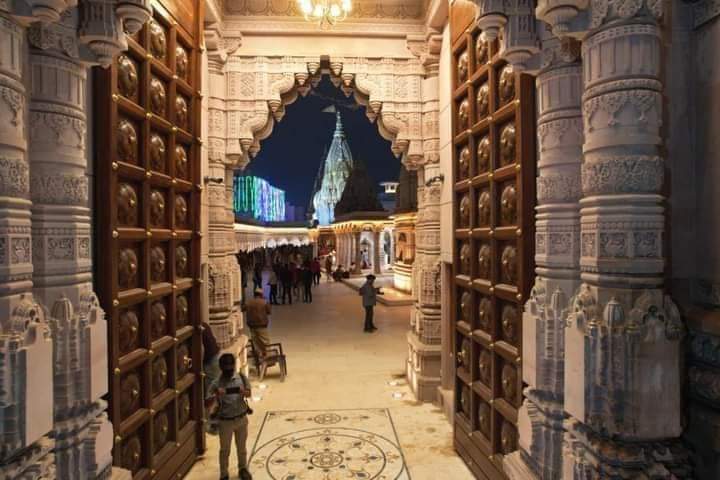
During the work of the project, more than 40 historical archaeological temples were found, which are invaluable heritage for crores and crores of countrymen. This development work is also an example of the fact that while preserving the archaeological things, its spirit remains intact.
Keeping in view, how modernity can be brought, how systems can be made modern. This development work, which reconnects Baba Vishwanath Dham with Mother Ganga, is going to give a new identity to Kashi in the whole world and this Dham itself is going to become the center of social consciousness of the entire Kashi’s new consciousness.
The initiative taken by Prime Minister Shri Narendra Modi for the rejuvenation of Kashi Vishwanath Dham could be accomplished with the intensive supervision of Chief Minister Yogi Adityanath ji and the support of the devotees and great people of Kashi. The Shri Kashi Vishwanath temple complex, spread over an area of about 50,000 square meters, was built by M. According to the thinking of Prime Minister Shri Narendra Modi, it has been established as a center of clean, excellent and spiritual energy.
The rejuvenation of the Shri Kashi Vishwanath temple complex and the paving of a grand straight path without any obstruction to the holy water of Maa Ganga will be inscribed in golden letters. Earlier this task was considered impossible. In the context of this great virtuous work, a verse line-by-line of the Ethics written by Acharya Bhartrihari is relevant.
Vighnaih again punarpi pratihanyamanah, prabhaya chotamajanaah na parityajanti. That is, people of the best class do not rest without completing the work started even after repeated obstacles.
There were also various obstacles in realizing Shri Kashi Vishwanath Gham’s vision. For example, to develop about 400 properties and rehabilitate 1400 persons and shopkeepers residing in them. Keeping the religious and cultural symbols intact, construction of buildings with modern facilities and restoration of ancient temples and cultural sites. In order to realize the vision of the Dham, discussions with religious persons, dialogue with the residents and explaining the basic features of the project were completed within the stipulated time frame. For this, of course, the residents of Kashi are also worthy of thanks, who gave wonderful cooperation in making these odd situations easier. At the same time, the cooperation and support of scholars, dignitaries including Kashi’s revered saint, Shri Kashi Vidvat Parishad is also overwhelming.
THE NEW GRAND FORM OF SHRI KASHI VISHWANATH DHAM
The main attraction of Shri Kashi Vishwanath Dham is the buildings built in the temple premises and the structures of spiritual and religious importance. In this, Rs.386.70 crore has been spent on building construction. For the expansion of the temple complex, Rs 489.05 crore was spent in the building order. During the construction/expansion of the corridor, 40 temples located inside the adjoining houses were found along with the Deities. All these 40 temples have been renovated with ancient grandeur and restored like a manimala. Following are the features of the newly constructed campus
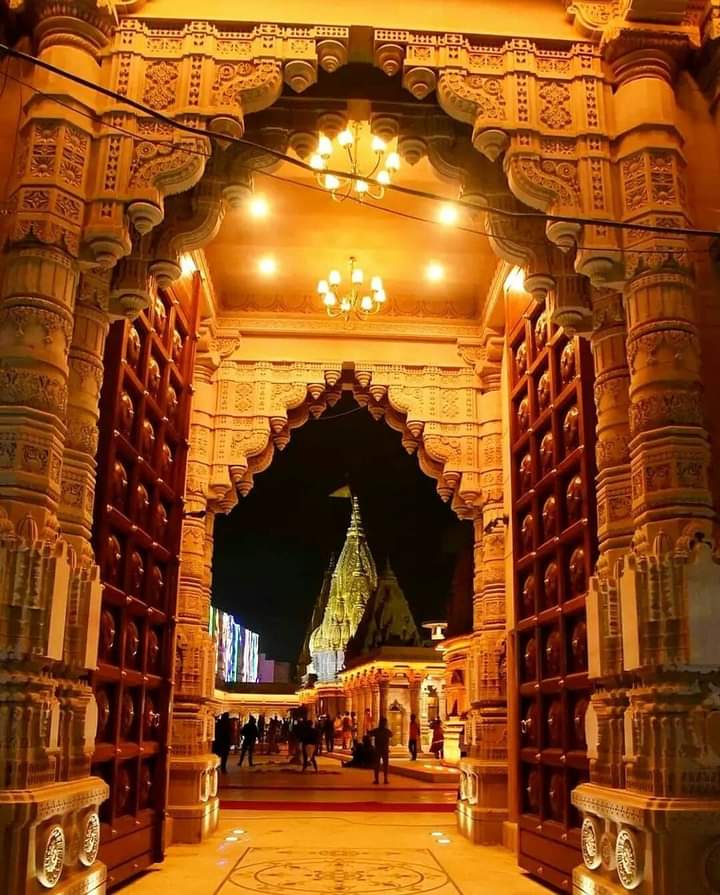
Temple Complex
The main attraction of Shri Kashi Vishwanath Dham is the temple complex in which four grand gates have been constructed in the circumambulation path. Chunar red sandstone, Makrana marble have been used in Shri Kashi Vishwanath Dham. From the point of view of architecture, incorporating the architecture and spiritual spirit of Kashi, the complex has been decorated with arches, bells, pillars, circumambulatory passages and stone lattices. Devotees will have a grand and divine feeling in the main complex.
Traveller’s Facilitation Center
There is a security check and locker facility for the pilgrims in the Yatri Suvidha Kendra built under Shri Kashi Vishwanath Dham.
Shopping Complex
With the construction of the shopping complex, necessary worship materials, donation items and worship tools and other useful items will be available to the devotees in the premises itself. This will increase business and employment.
Varanasi Gallery
The area of this building is 375 sqm. The said building is situated between the Multipurpose Hall and the City Museum, near the Karuneshwar Mahadev Temple. interior of the said building Spiritual and religious narratives were narrated through paintings on the walls.
City Museum
The area of this building is 1143 sqm, which is situated between Varanasi Gallery and Mumukshu Bhawan. This building is G+1. There will be a reception in this building, which will direct the exhibition space. This building will have big rooms and small rooms. This building has been built with a view to facilitate the travelers to have information about antiquities.
Mumukshu Bhawan
The above building is constructed in 1161 sqm G+2, which is situated just after the grand gate of the temple square. It has been built to take care of all the visiting elderly passengers and sick people, and arrangements have also been made for beds and wards in the building. Apart from the stairs in this building, arrangements have also been made for lift, reception, toilet for the convenience of the elderly and patients.
Guest House
This building is constructed in 1962 sqm G+2, which has been specially constructed for the accommodation of the visiting passengers/visitors.
Vedic Center
This building is constructed on 986 sqm G+1. The building is located opposite Passenger Facilitation Center-3. The building has been constructed for conducting spiritual exhibition, meeting/ceremony.
Multipurpose Hall
This building is constructed in 976 sqm G+1. The building is located near Manikarnika Square. The multipurpose hall has been constructed to conduct public service works. The said building can accommodate 200 to 300 people at a time. In addition, an escalator has also been arranged in it.
Tourist Facilities Center
This building is constructed on 1061 sqm G+1. The purpose of the construction of the building is to make a hall at Manikarnika Ghat, to organize the logs and to make available various types of information by making a convenience center for the passengers on the upper floor. This building will not only be a convenience center for the passengers coming to the entire Ghat range, but it will also be commercially important due to its proximity to the Ghats.
Toilet Black 1 n 2
In view of the convenience of the passengers, toilet blocks have been constructed in the gham.
Restaurant
This building is constructed in 1119 sqm G+1, which has been constructed for the food court and seating facility for the passengers.
Spiritual Books Store
This building is constructed on 311 sqm G+1. The building has been built in a plaza along with the City Museum and the Varanasi Gallery, which also includes a spiritual bookstore/shop.
IMPORTANT TEMPLES OF VARANASI
Kashi, the city of Baba Vishwanath, is also considered the abode of the gods. Apart from Baba Vishwanatha here, other important temples were also established from time to time, which have a very holy place in the people of Banaras. It is considered auspicious and obligatory to visit many other temples after the darshan of Baba Vishwanath. The temple of Mata Annapurna is also located in Shri Kashi Vishwanath Dham, from where the sacred Deity of Mata Annapurna was stolen 108 years ago and went to a Canadian museum abroad. This holy Deity could be brought back to India by the wonderful efforts of the successful Prime Minister of the country and it was re-established in the temple by the popular Chief Minister of the state, Yogi Adityanath on November 15, 2021. Due to this, devotees have started getting the completeness of the darshan of Mata Annapurna after the darshan of Lord Vishweshwar.
Apart from this, other very holy and important temples like Kumbha Mahadev Temple, Balmukundeshwar Mahadev Temple, Shri Neelkanth Mahadev Temple, Brahmeshwar Mahadev Temple, Chandragupta Temple, Gangeshwar Mahadev, Amriteshwar Mahadev, Jai Vinayak etc. are located in Shri Kashi Vishwanath Dham.
Apart from this, the details and significance of other important temples located in Kashi are described following
THE KAAL BHAIRAV TEMPLE : This temple is worshiped as the main Bhairav under Ashtabhairava and his importance as the Kotwal of Kashi is known to the world. Whoever comes to Kashi, it is necessary for him to have darshan of Baba Kaal Bhairav. There is a lot of mention of Bhairav worship in the scriptures.
BHARAT MATA TEMPLE : This temple is located in Kashi Vidyapeeth courtyard at Sigra in Kashi where the full form of Mother India is depicted. This place is a sight to behold.
DEVI VISHALAKSHI TEMPLE : This temple comes under 51 Shaktipeeths. This Shaktipeeth was established here when the Manikarnika of Goddess Sati fell. This temple at Meerghat Patit Pavani is near Maa Ganga. All the wishes are fulfilled by its darshan and worship.
SANKAT MOCHAN TEMPLE : In this temple, Lord Hanuman’s real deity form is revered. It is believed that by visiting this temple, the blessings of Lord Hanuman ji along with Lord Shri Ram ji remain in life.
DURGA MATA TEMPLE : This temple is famous among the nine goddesses as Krishnamanda Devi. On the fourth day of Navratri, all the wishes are fulfilled by the darshan of the mother in this temple..
TULSI MANAS TEMPLE : This temple is the main temple of Kashi. Sampoorna Ramcharit Manas. It has been engraved on the walls of the temple, which is visible and revered.
CHINTAMANI GANESH TEMPLE : This temple is the temple of Lord Ganesha, who can cure all kinds of worries.And is worshiped for removing mental and physical obstacles.
BATUK BHAIRAV : This is the child form of Lord Kaal Bhairav under Ashtbhairav temple.’s temple. Various types of worship are performed in this temple.
MARKANDEYA MAHADEV TEMPLE : This temple is located in Kaithi village of Varanasi. in this temple. There are different types of Jalabhishek and worship rituals for the purpose of getting a son.


